Fruit Growing Guide
Growing fruit plants and trees is harder than most folks first think. Fruits need continuous care from spring to fall. From pruning, fertilizing, checking pH, pest and disease, and harvesting. This guide will help you care for your fruit plants and harvest heavy yields of healthy fruit!
There are many different types of fruits that can only be grown in certain climates throughout the United States. Some fruits have different varieties that grow better in certain zones. It is always best to be certain that the fruit varieties you purchase will grow in your garden zone. Fruit plants can only take a specific cold temperature and if your zone gets below this all your work will be for none. So the single most important factor when choosing perennial fruits is making sure they are adapted to your zone.
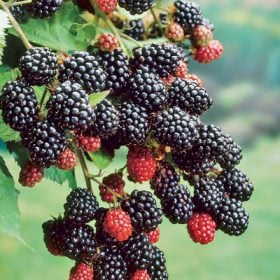
Blackberry
Learning Download: How to Grow Blackberries
Location: Full Sun. Good air circulation is important to prevent fungal diseases. Blackberries send up suckers many feet from the parents so leave room for mowing them down.
Soil: Prefer a well draining, acidic (low pH 6.0-7.0), sandy soil. Clay soil should be amended with organic matter. If possible, do a soil test and amend the soil before planting.
Hardiness: 4-9 (varieties will vary)
Minimum Chill Hours Needed: 500 hours
Planting: For best results, plant your blackberry bushes in early spring. Once your plants arrive soak roots in water for 3-6 hours. Remove any broken roots. Do not let roots get direct sun before planting. Although weird this can kill the plant. Dig a hole twice the size of the roots on plant. Space plants 2-4′ apart and rows 4-6′ apart. Shovel dirt back into hole and add organic matter. Mulch around plant first year only to keep moisture in.
Watering: Water blackberries plants during the day. Water more frequently the first 2-3 weeks after planting. Blackberries like 1″-2″ per week during growing season and up to 4″ per week during harvest. The plants are rather shallow rooted, so moisture needs to be at the surface.
Fertilizing: Blackberries like a general purpose 10-10-10 fertilizer. Keep fertilizer 3-4′ away from stem to avoid burning the plant.
Pruning: First year erect canes should be left unpruned. Following year canes should be pruned back to 3-4′. Pruning encourages lateral branching and increases cane strength, so they don’t fall over in snow and wind. Pruning should be done early in the growing season to decrease wound time. Lateral branches should be cut back to 1-2′. Burn or throw away any clippings.
Wildlife Protection: Netting is the most effective protection from birds and wildlife.
Pollination: Self pollinator
Harvesting: Blackberries take on average 3 years to produce a full crop of berries. When the berries turn shiny black, wait a few days to let them soften and lose their shine. Harvesting in the morning on cool, dry days will result in a longer shelf-life. Do not wash the berries until ready to use them. Keep refrigerated.
Winter Protection: Choose varieties that are adapted to your zone. Mounding soil high around the base.
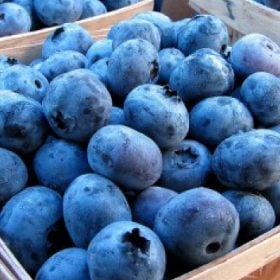
Blueberry
Learning Download: How to Grow Blueberries
Location: Full to partial sun. Good air circulation is important to prevent fungal diseases.
Soil: Prefer a moist, acidic (low pH 4.0-5.2), well drained soil. Clay soil should be amended with organic matter. Lower pH with straight elemental sulfur.
Hardiness: 3-9 (varieties will vary)
Planting: For best results, plant your blueberry bushes in early spring. Once your plants arrive soak roots in water for 3-6 hours. Remove any broken roots. Dig a hole twice the size of the roots on plant. Space plants 4-6′ apart and rows 7-12′ apart. Shovel dirt back into hole and add organic matter. Mulch around plant first year only to keep moisture in.
Watering: Soil should have rich compost to hold moisture. Water blueberry plants during the day. Water more frequently the first 2-3 weeks after planting.Blueberries prefer 1″ per week during growing season and up to 4″ per week during harvest. Water evenly around entire plant. Too much watering can lead to bland fruits.
Fertilizing: Do not fertilize blueberries first year. Henceforth use an acid loving 10-10-10 fertilizer. Fertilize in spring, again when buds appear and lastly one month after buds first appear.
Pruning: Pruning is unnecessary the first 2-3 years. Remove any dead debris during this time. After this time remove older canes to focus growth on newer canes. Prune when dormant in late winter to early spring.
Wildlife Protection: Netting is the most effective protection from birds and wildlife.
Pollination: Self-pollinating. Benefit from cross-pollination. Grow 2-3 types together for best results.
Harvesting: Most blueberries take 2 years to produce a full harvest. Pick 1 week after berries turn completely blue for maximum sweetness. Harvesting in the morning on cool, dry days will result in a longer shelf-life. Do not wash the berries until ready to use them. Keep refrigerated.
Winter Protection: Choose varieties that are adapted to your zone. Mounding soil high around the base.
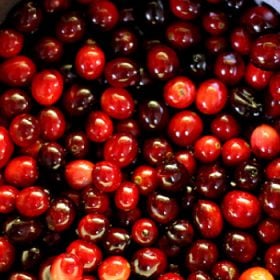
Cranberry
Learning Download: How to Grow Cranberries
Location: Full sun. Good air circulation is important to prevent fungal diseases.
Soil: Prefer a moist, acidic (low pH 4.0-5.0), well drained soil. Clay soil should be amended with organic matter. Lower pH with straight elemental sulfur.
Hardiness: 3-9 (varieties will vary)
Planting: For best results, plant your cranberry plants in early spring. Once your plants arrive soak roots in water for 3-6 hours. Remove any broken roots. Dig a hole twice the size of the roots on plant. Space plants 1-2′ apart. Shovel dirt back into hole and add organic matter. Mulch around plant first year only to keep moisture in.
Watering: Soil should have rich compost to hold moisture. Water cranberry plants during the day. Water more frequently the first 2-3 weeks after planting. Water evenly around entire plant but do not let puddles form. Too much watering can lead to bland fruits.
Fertilizing: Avoid excess Phosphorus. Add extra nitrogen the first couple years to get the runners to fill in the bed. Once plant is grown, cut back on nitrogen. When plant is established try adding a 2-4-2 fish emulsion fertilizer in early spring, once buds start forming and lastly when berries start to appear.
Pruning: Once plants are established in 3rd year, they can be lightly brushed with a garden rake in early spring. Only prune long runners and not upright branches.
Wildlife Protection: Netting is the most effective protection from birds and wildlife.
Pollination: Self-pollinating. Encourage bees into the garden.
Harvesting: Harvest before first frost in your area. If you want to wait a bit longer than cranberry plants should be covered at night to protect from frost.
Winter Protection: Choose varieties that are adapted to your zone. Mounding soil high around the base.
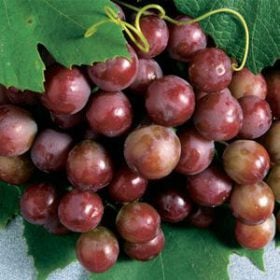
Grapes
Learning Download: How to Grow Grapes
Location: Full Sun or at the very least full morning sun with some afternoon shade. Good air circulation is important to prevent fungal diseases.
Soil: Prefer a well draining, deep and loose soil. Grapes are adapted to a wide range of soils and are forgiving. Best pH is between 5.5-6.5.
Hardiness: 4-9 (varieties will vary)
Planting: For best results, plant your grape plants in early spring. Once your plants arrive soak roots in water for 3-6 hours. Remove any broken roots. Dig a hole 12″ deep and 12″ wide. Space plants 6-10′ apart. Shovel dirt back into hole and add organic matter. Mulch around plant first year only to keep moisture in. Grapes need a trellis or arbor for support.
Watering: Water grapes in early morning to allow drying throughout the day. Water more frequently the first 2-3 weeks after planting. Grapes prefer 1″-2″ per week during growing season and up to 4″ per week during harvest. Keep soil moist but do not let water build up in puddles.
Fertilizing: No need to fertilizer the first year and only slightly fertilize the second year. Thereafter use a well balanced fertilizer 10-10-10.
Pruning: Pruning is important. Not only would the plants go wild they would only produce minimal fruits. Prune annually when vines are dormant in March or April. Remove up to 90% of last years growth! The more you prune the more grapes you will harvest.
Wildlife Protection: Netting is the most effective protection from birds and wildlife.
Pollination: Most varieties are self pollinator. If not, two varieties that can pollinate each other are needed.
Harvesting: Watch grapes and test the fruit before picking. When ready, cut from vine and they are ready for eating.
Winter Protection: Choose varieties that are adapted to your zone. Mounding soil high around the base.
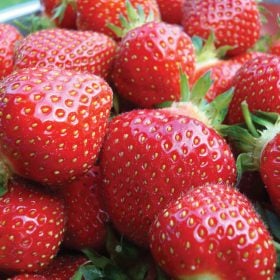
Strawberry
Learning Download: How to Grow Strawberries
Location: Strawberries require 6-10 hours of sun daily. Good air circulation is important to prevent fungal diseases.
Soil: Prefer a loamy soil but will tolerate many soil conditions. pH should be between 5.5-7. Planting site should be well drained.
Hardiness: 3-9 (varieties will vary)
Planting: For best results, plant your strawberry roots in early spring. Once your plants arrive soak roots in water for 3-6 hours. Remove any broken roots and cut back to 8″ if necessary. Plant on a cloudy day. Dig a hole to cover roots but leave top crown exposed. Space plants 18″ apart and rows 3-4′ apart. Mulch around plant first year only to keep moisture in. Planting in a raised bed is preferred to keep plants contained, well drained and away from pests.
Watering: Watering frequently is very important. Biggest problem that occurs is dried roots and the plant dies. Water at least 1″ per week spread out every couple days.
Fertilizing: Apply 1 pound of 10-10-10 fertilizer one week before transplant strawberries. Add fertilize every spring before growth begins. Everbearing strawberries should be fertilized again once first berries are picked.
Pruning: When growing season is over, cut all foliage back to 1″ above ground and mulch for winter.
Wildlife Protection: Netting is the most effective protection from birds and wildlife.
Pollination: Self pollinator.
Harvesting: First year all flowers should be removed to encourage strong root growth. Although tempting to harvest strawberries the first year you will pay for it the following year. Harvest when strawberries are red and soft to the touch the second year.
Winter Protection: Choose varieties that are adapted to your zone. Mounding soil high around the base.
